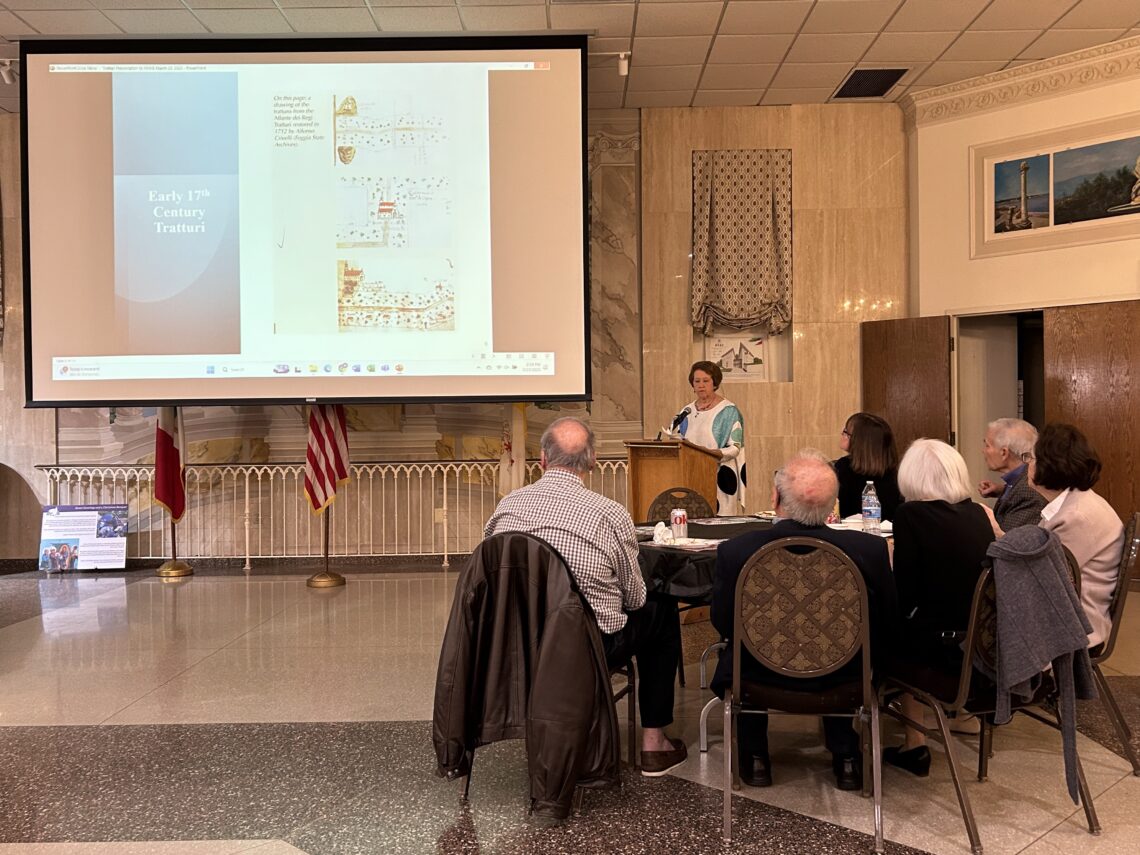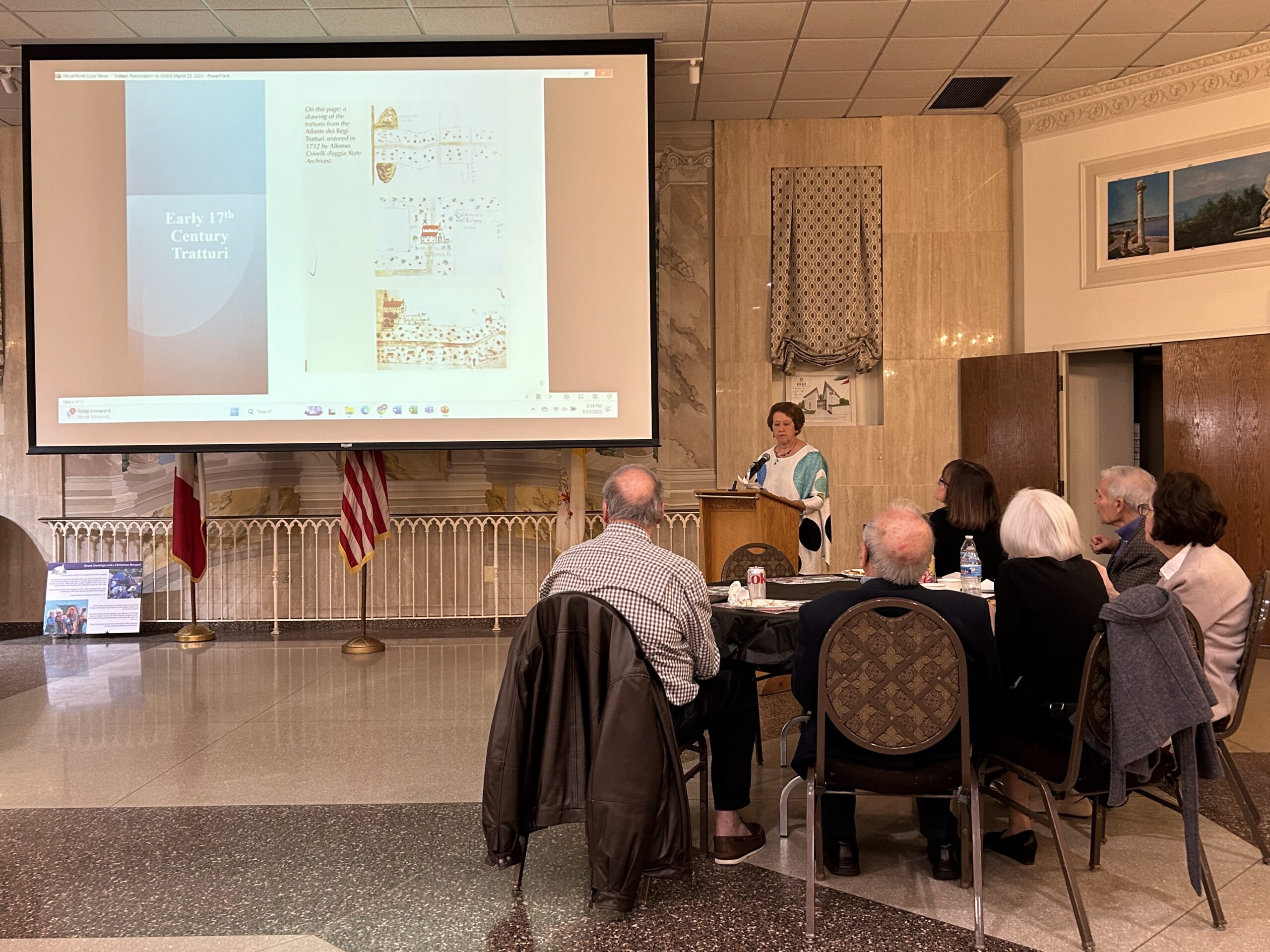
Along the Shepherds’ Tracks: Traturri and Transumanza
By Carmine Spellane

At the most recent AMHS general meeting, held on March 23 at Casa Italiana, former Society President Maria D’Andrea-Yothers reprised her presentation on the famed herding trails in Abruzzo and Molise, known as the trattoria which make up the interconnected system known as the transumanza.
Maria said that people who have had the pleasure of visiting Abruzzo and Molise, traveling on roads connecting various villages and towns, might have noticed something relatively new – markers placed on the shoulder of these roads reminding travelers that they are approaching a “tratturo”, or track, not easily visible, that, over time, formed a path in the seasonal migration of sheep and other animals, referred to as the “transumanza”. The term derives from the Latin “trans” (across) and “humus” (ground).
Maria recounted how, since the earliest days of ancient history, the story of Abruzzo and Molise has been shaped by the harsh mountainous character of its territory. The regions, containing the two highest mountain groups of the Apennines – the Gran Sasso and the Majella Massifs – with peaks close to 3, 000 meters, or 10,000 feet – have been conditioned by the traditions and lifestyle of sheep-rearing communities. Their high-altitude valleys, rocky slopes, and vast mountain plains have been the ideal environment for sheep and shepherds.
For centuries, sheep-rearing provided a livelihood for more than half the population of Abruzzo and Molise and, from pre-Roman times until recently, was the basis of their economies, social fabrics, and cultures, shaping population spread, landscape (both natural and agricultural), layout of towns and villages, and the earliest communication routes.
The shepherd’s tracks are routes used by livestock linked to the transumanza, a type of grazing based on the seasonal movement of herds between various regions with different climate. When the lower plains become arid because of the heat, herds and shepherds move to the mountains in spring and return to the plains in autumn. In Italy, these tratturi cross the regions of Abruzzo, Molise, Puglia, Campania, and Basilicata.
Research has identified five main “traturri” in the regions: L’Aquila-Foggia (blue); Centarelle-Montesecco (yellow); Celano-Foggia (red); Pescasseroli-Candela (pink); and Ateleta-Biferno (green).
These “tratturi” extended for distances of 250 to 300 kilometers, or from 150 to 200 miles, and followed well-developed routes, established over centuries of regular use. From the Roman period onward, and in particular during the reign of the Aragonese (Spanish occupation of parts of Italy in the 11th to 15th centuries), these routes were rigidly determined and legally protected by edicts issued by the regions’ governors.
The stability for the seasonal movement of flocks between the two regions and Puglia was provided by the institution of laws, “Lex Agraria Epigraphis” (agrarian laws), designed to regulate the use of public grazing lands and routes for the movement of livestock or “calles”, later known in Italian as “tratturi”.
During the Middle Ages, seasonal migration almost came to a halt, due to political destabilization and feudal conflicts, making the “tratturi” unsafe. “Transumanza” surfaced again under the Normans in the years from 1000 to 1200 A.D., primarily due to the influence of the Benedictine monks.
These monks had a profound impact on the social, economic, and cultural development of the region, contributing to the promotion of sheep rearing, which made the region of Abruzzo Europe’s leading producer of wool. Government regulation of these enterprises came about under Spain’s King Alfonso I of Aragon, who established a “dogana”, or custom house, in Foggia, Puglia, for the collection of taxes and duties from the use of the tratturi and grazing rights for the sheep. Regulations were also established for the time of the year the livestock were permitted to migrate. In early May, all forms of livestock migrated to the Appenine pasture, whereas the migration to the south, toward Puglia, was more diversified: sheep and goats entered Puglia in mid-September, and cattle in mid-December.
In the beginning of the 15th to the 16th century, sheep rearing began to decline, accelerated by a shift in land use from grazing to farming, as laws were enacted to encourage the growing of crops. The economic transformation began to destroy the traditional interdependent system of agriculture and sheep rearing on which the economies of the two regions had been based for centuries. Many villages that once were mainly devoted to the raising of sheep, wool, cheese, etc., began to be de-populated and in some cases were abandoned all together.
Maria also offered some observations on the shepherds – these sturdy, dedicated men who cared for the animals. During the seasonal migration, shepherds would walk hundreds of kilometers in the company of their livestock, a walk that would average three weeks or more to reach the grazing pastures. This trek would include nightly stopovers involving the setting up of temporary fences known as ‘stazzi’ to keep the sheep contained and a roof over the shepherd’s head.
The shepherds shared their living conditions with their flocks. It was a rugged life, lived in isolation, in the open, physically bound to the caring of their flocks for 10 to 11 months out of the year, and also conditioned by the grazing needs of the flocks and available pastures.
The diet of the shepherds was very simple and austere: bread, complemented by herbs and vegetables such as chicory, onions, and plenty of salt. Besides a meager wage, shepherds were given a kilo of bread daily.
Dry-stone huts served as shelters for the shepherds and enclosures for the livestock. The conical shape of the roof looks like the “trulli” from Puglia, but in Abruzzo, they are called “palace.”
Some huts were about 6 meters (20 feet) in height and were built by placing an ever-decreasing concentric layer of limestone slabs on top of each other so that the wall would close in to form the conical roof. Caves were common in the lower elevations; the caves were very sparse and rustic but served the needs of both sheep and goat herders.
The Cane da Pastore Maremmano Abruzzese, or Mastiff, was and is critical to the survival and care of the shepherd and his flock. The dog is the product of a rich tradition of sheep rearing in Abruzzo. They are considered one of the best breeds in the world for protecting sheep from wolves, bears, and other predators.
Maria noted that since the late 1970s, a number of Ministerial Decrees have recognized the historic and artistic importance of the tratturi, offering various forms of protection. These decrees also allowed for the transfer of the tratturi, the land, and the livestock, from the state to local regional bodies.
A concerted public appreciation and awareness of the “traturri” has given energy to restore their historical significance to the regions’ rich cultural heritages. They offer unique tourist attractions for trekking and horseback riding that have become very common in recent years. The preservation of the tratturi has made the “transumanza” an original and unique patrimony.
Today, tourism companies have found ways to amplify the importance of the traturri to more and more visitors to the region. For example, Hidden Trails offers an eight-day, seven-night trip that starts in Isernia, Molise into Abruzzo, following the tratturi on two mountain treks, the Parco Nazionale della Majella and the Parco Nazionale d’Abruzzo.
The tratturi have also been memorialized by Gabriele D’Annunzio, the famous poet of Abruzzo, in his poem titled “I Pastori,” which was included in the collection Alcyone – Sogni di terre lontane composed between 1903 and 1907.
Starting with the famous words “Settembre, andiamo…” It is a nostalgic poem, written by D’Annunzio while he was away from his homeland and longing for its colors, tastes, sounds, and mountains. Maria asked Natasha Rovo to read the poem in Italian. (To read the poem in English and Italian, click HERE.)
The presentation marked Maria’s final appearance at an AMHS meeting. She and her husband, Sam Yothers, are moving to North Carolina in the summer. The assembled members and friends wished Maria a fond farewell and heartfelt thanks to her many contributions to the Society.
Summer 2025





